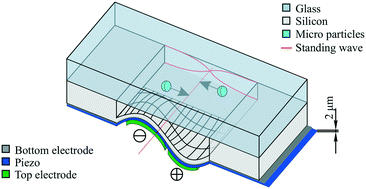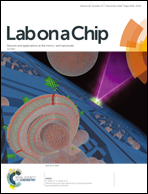Thin film piezoelectrics for bulk acoustic wave (BAW) acoustophoresis†
Abstract
Acoustophoresis, the movement of particles with sound, has evolved as a promising handling tool for micrometer-sized particles. Recent developments in thin film deposition technologies have enabled the reproducible fabrication of thin film piezoelectric materials for miniaturized ultrasound transducers. In this study, we combine both technologies and present the first implementation of a thin film Pb(Zr,Ti)O3 (PZT) transducer as actuation source for bulk acoustic wave (BAW) acoustophoresis. The design and fabrication process was developed for thin film BAW (TFBAW) devices. High-quality piezoelectric layers were produced using Solmates SMP-800 pulsed laser deposition (PLD) equipment which enables wafer-level batch fabrication. Results from simulations and experiments enabled the characterization of different designs and the prediction of the pressure field inside the TFBAW device. Moreover, the acoustic streaming field was analyzed to determine critical particle diameters for acoustophoresis. Operation conditions were identified for the acoustophoretic unit operations particle concentration and sorting. The TFBAW device was able to generate a high acoustic pressure amplitude of 0.55 MPa at a low peak input voltage of 0.5 V. Overall, this study demonstrates that TFBAW devices have the potential of a miniaturized, predictable and reproducible acoustic particle manipulation at a low voltage for lab-on-a-chip applications.



 Please wait while we load your content...
Please wait while we load your content...